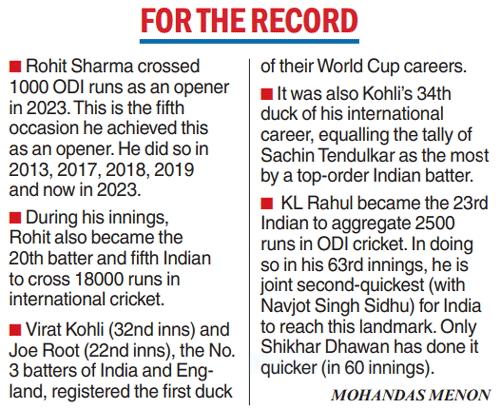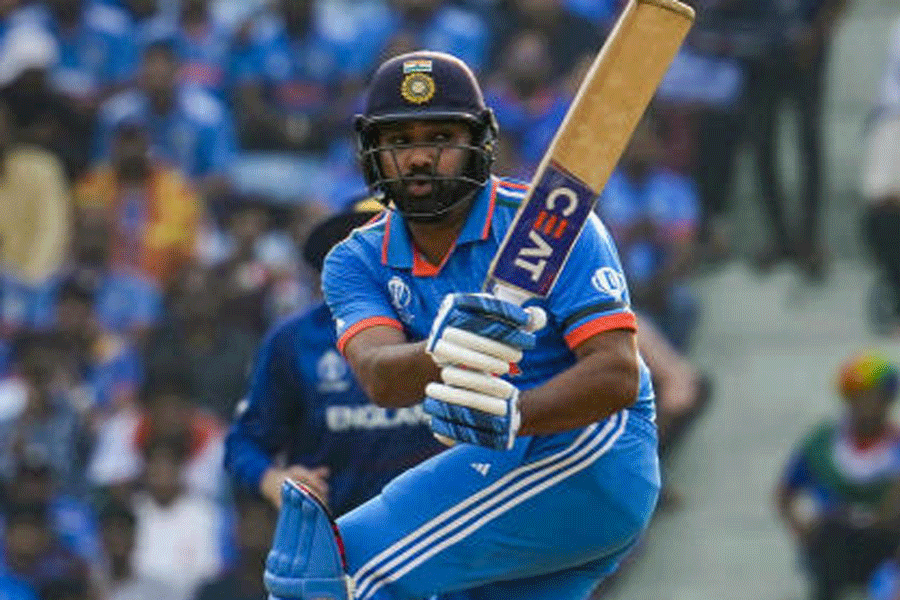In the city of the Nawabs, Rohit Sharma proved to be the king when it came to elegance and grandeur.
It was only on the eve of the contest that KL Rahul was probed about the middle-order’s efficacy and he responded by terming it as a “challenge”.
In the absence of Hardik Pandya, it was evident how much the team depended on the top three in their line-up. Rohit’s solid 87 and his 91-run partnership with Rahul went a long way in posting a competitive but below-par 229/9 on Sunday. Such ineptitude from the middle and lower orders could return to haunt India in the knockouts if corrective measures are not put in place.
Shreyas Iyer’s inability to battle through the middle overs was laid bare again while both Rahul and Suryakumar Yadav were guilty of throwing their wickets away when their presence would have made a world of a difference.
India had to get through 57 deliveries with their tail exposed and except for Jasprit Bumrah’s 16 off 25 balls, none showed the ability to leave a mark.
Jos Buttler’s decision to bowl first did come as a surprise, especially the manner in which England’s famed batting collapsed against Afghanistan at the Kotla and South Africa in Mumbai.
But England had done their calculations well to stop the marauding Indian top-order. The newly laid wicket suited their fast bowlers since it was two-paced — slow yet offered good bounce. India’s batting struggled in the face of a focused and disciplined English attack.
Buttler knew they had a chance if they managed to dry up the Indians’ big hitting ways. David Willey set the trend with a maiden opening over. Rohit broke free in the left-arm pacer’s next over with two sixes and a boundary but that wasn’t enough to relieve the pressure.
There was lateral movement in the air initially and the English bowlers used the wobble seam to bring in the variation. The Indians tried to counter it by coming down the track but the length proved difficult to get away.
Their failure to rotate the strike piled on the pressure. Like Shubman Gill, Virat Kohli was beaten by the seam movement after struggling to get off the mark, having battled for nine balls.
The dot-ball pressure finally got to Kohli as he tried using his feet but Willey had shortened the length resulting in a top edge. England limited India to 35/2 in the first Powerplay. The circumstances got to Shreyas as well.
Even the best were guilty of not picking the singles. Rohit faced 57 dot balls, almost half of the numbers he faced, while Rahul countered 30.
The alarm bells have been sounded and can’t be ignored for long.
Shivers down the middle
There was one message which was delivered loud and clear on Sunday. As the Indian middle and lower order struggled to get going, Hardik Pandya’s absence was being felt at every moment.
Pandya, who strained a ligament in his left ankle while trying to stop a ball on his follow-through during the match against Bangladesh, is unlikely to be back in the playing XI before their last league match against the Netherlands in Bangalore on November 12.
Sources told The Telegraph that Pandya has started to bat at nets at the National Cricket Academy (NCA). It is expected that he will be able to bowl this week, but the NCA is unlikely to rush him into the thick of action.
Given that Pandya is considered prone to injury, the team management and the NCA don’t want to risk him since it might lead to further complications. The team has been doing well and his presence is more crucial during the knockouts.
Pandya’s absence though has affected the team’s balance. While the three-pronged pace attack has been unplayable, the lower-order batting has suffered since he provides depth and is capable of forging partnerships with the Jasprit Bumrahs and Kuldeep Yadavs.
INDRANIL MAJUMDAR












